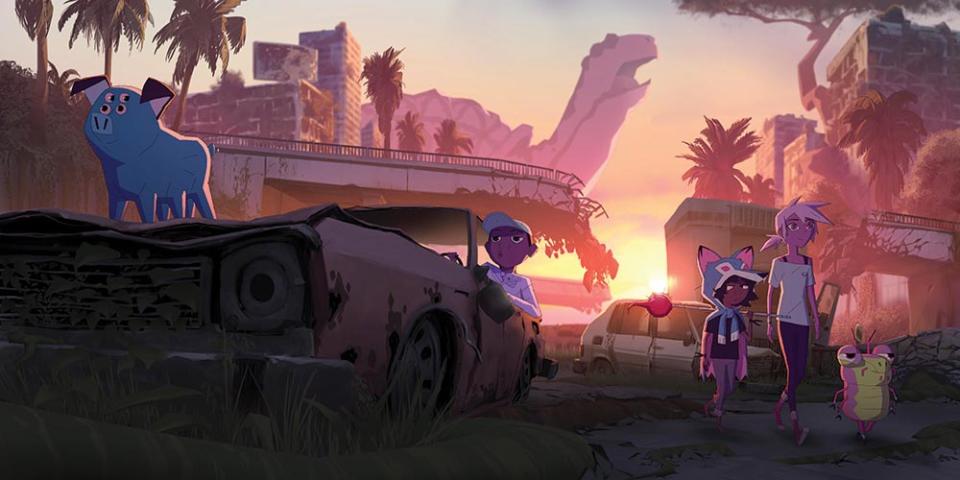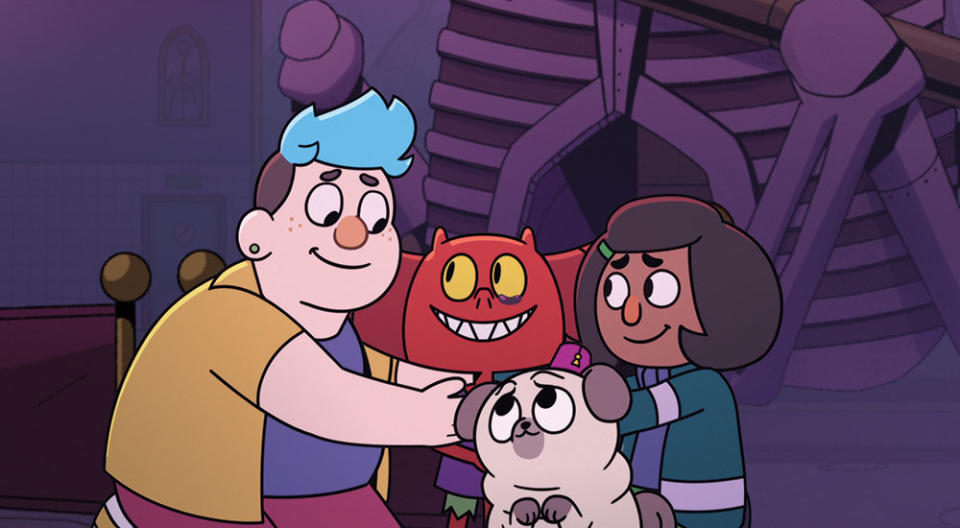How Comics Creators and LGBTQ Inclusion Are Fueling TV Animation’s Young Adult Genre

In the animated series Dead End: Paranormal Park, vain ghosts, egotistical demons and a hilariously haunted park are no match for human teens Barney and Norma and talking dog Pugsley.
Neither are TV animation’s traditional age demographics. One of the newest entries in the “Netflix School Special” programming block, the show mixes horror and action elements with comedic and heartfelt coming-of-age storylines — led by two LGBTQIA+ identifying teens — in ways that defeat the age-old animation binary that sees content strictly for adults or (younger) kids.
More from The Hollywood Reporter
Best of Show Winner 'The Seine's Tears' Leads SIGGRAPH Computer Animation Festival Lineup
Postproduction Workers at ShadowMachine Unionize With the Editors Guild
How 'Kung Fu Panda: The Dragon Knight' Expands a Nearly 15-Year Franchise
The series exists instead within a space that has more noticeably emerged during the last half-decade: young adult animation. Dead End creator and showrunner Hamish Steele tells The Hollywood Reporter that when they were developing and pitching the show between 2018 and 2019, “there was some stuff like [Cartoon Network’s 2019-21 anthology series] Infinity Train, but that realm didn’t really exist.”
Because of that, Steele — who adapted the series from their webcomic and graphic novel DeadEndia — says they aged their leading characters down from the books while pitching the show, before aging them up again to around 16 and 17 while developing it. That initial choice was in response to a longstanding children’s and family business model, seen at legacy studios like Cartoon Network, Disney and Nickelodeon, that has historically focused on just two audience markets: preschool and 6 to 11.
“There really wasn’t much animation done for audiences older than that within the kids and family businesses,” DreamWorks chief creative officer, television Peter Gal tells THR. “Kids can start to get interested in live-action at that point, so the live-action tween programming took over.”
Before and within the early 20th century, animation in the U.S. was made by individual artists and eventually studios for a broad range of ages and purposes, from film and TV entertainment shorts to public information spots. But with the arrival of celluloid film and later television, the rise of studios like Disney in the 1920s followed by others like Hannah-Barbara in the ’50s and ’60s, and the establishment of the Saturday morning cartoon block (and its toy-heavy commercials), younger audiences developed into TV animation’s primary audience.
In the process, potential animation programming for older viewers — including young adults — got somewhat lost in the shuffle.
“I think there’s an age group that cartoons just sort of abandoned for a long time and assumed that when you get to about 12 or 13, you’re just watching adult shows,” Steele previously told THR. “That’s fine; there’s a lot of adult programming that’s good. But there’s so much stuff that happens before then that’s such an important part of your life, and the thought that people will jump from Steven Universe to Euphoria — that’s such a huge jump.”
YA as a genre is still relatively new in animation, but the industry hasn’t been completely devoid of content for the 12 to 18 market. Beyond Dead End and other more recent titles that could be classified as YA like The Owl House and The Proud Family reboot, early entries included 6teen, Braceface, The Legend of Korra and the first two seasons of Young Justice.

Nickelodeon/Courtesy Everett Collection
All broke ground between the 2000s and early 2010s with their mix of more genre-heavy narratives (like sci-fi and fantasy), complex themes, darker comedy and mature emotional storylines. Each also played a role in delivering LGBTQIA+ representation in a genre that rarely featured it. It’s the kind of space — and topics — creatives are eager to explore, in the U.S. and beyond.
“There’s no denying that I want a Are You There God? It’s Me, Margaret moment in an animated show,” Taneka Stotts, Pinecone & Pony’s story editor, says. “I would love to talk about the things that I actually went through as a teen — the things other people went through as teens.”
Stotts isn’t the only one. During the 2021 Cartoon Forum — a pitching and co-pro forum for animated TV projects held in Toulouse, France — there was a noticeable increase in the number of YA-skewing projects, according to Kid Screen magazine. Kateryna Vyshnevska, head of development and co-productions at Ukraine’s Film.UA Group, even told the outlet the industry was in a “golden age of YA animation.”
The desire for this YA space has been fueled in part by the historically restrictive nature of children’s animation, where certain topics — think serialized stories featuring elements of puberty, romantic relationships and LGBTQIA+ characters — have historically remained off-limits. Preschool, which has traditionally placed a lot of focus on educational content, can be “really fun but still has to have this very formulaic setup each episode,” according to Stotts. Meanwhile, the older demo sees more entertainment-infused content that’s action-focused or “high-stakes comedy-hybrid TV shows.”
Stotts points to the standards and practices departments of legacy studios and networks as a key part of enforcing the kinds of content that can make it to the screen — from how kids’ safety is portrayed to the development of relationship stories. Places like Netflix and Apple TV+, they say, have relied less so on these departments, which can reinforce a company’s longstanding “core values.”
Gal says that with the arrival of Netflix and others, the industry is seeing “a democratization to streaming” where teen and young adult viewers and fandom “are finding and championing things that they might not have found in another world.” But he also notes an increase of comics creators in animation has also played a part in shaking things up, with several recent DreamWorks shows among those breaking ground in the genre.
“For a long time, I think the kids’ space was just really confining. There was this very clear line: This is what we do and this is what we don’t do. These are the rules,” Gal says. “The artists and creators who grew up in that studio system grew up with a bunch of rules. Then here come these graphic novel artists and writers who are creating this work on their own outside of that system, without the rules. They did what they wanted to do. There was no rule about ‘We don’t tell relationship stories or we do tell relationship stories or we tell these kind of relationship stories.'”

Courtesy of Netflix
“They just pushed the boundaries,” he adds, “because the publishing world that they were emerging into was not as confining as the kids and family animation world had been.”
Stotts, who started their career in comics before writing for series like Young Justice: Phantoms and the more YA-leaning Steven Universe: Future, notes that animation creatives with a comics background are used to making “books all-ages on purpose.”
“I wanted stories that kids could read and that parents could read with their children,” they say. “Because working at comic conventions, that’s what I got a lot of: parents asking me, ‘Hey, what do you recommend?'”
That broader audience approach is coupling with the rise of streamers that have “done more for breaking the kind of hold that TV had on which animated shows would appear” and a younger generation of creatives who grew up regularly consuming Western animation’s more age-inclusive Eastern counterpart anime.
“Other parts of the world have a deeper tradition of all ages watching animation, and then loving animation and there being more things that play to the full audience,” Gal says. “In America, it’s been pretty broken down into kid stuff and then the adult network comedies, and the occasional thing that breaks the mold.”
The growing group of creatives daring to challenge animation’s existing age boundaries is already resulting in a small uptick of shows, a number of them run by LGBTQIA+ creatives, that have been able to move their queer characters and storylines out of the subtext and incrementally into more overt representation.
Series featuring both leading and supporting LGBTQIA+ characters, like Kipo and the Age of Wonderbeasts, She-Ra and the Princesses of Power, The Hollow and The Dragon Prince, have delivered coming-of-age storylines about families of choice, first loves, identity and acceptance. And while filling a programming age-gap with their more intense action and nuanced explorations of topics like grief and power, they’re also game-changers in a space that has historically treated gender and sexuality diversity as untouchable.
“My show is based on a webcomic and when I was making it as a webcomic I truly didn’t think too hard about representation,” Steele tells THR. “I was literally just writing the world around me. The whole show is the real world meets the demon world and to me, the real world is queer and diverse. That’s what normal looks like to me.”
In Steele’s case, the YA emergence has resulted in a show that features a racially and ethnically diverse set of characters, led by one of animation’s first known trans male leads, Barney (voiced by trans actor Zach Barack), who, along with the paranormal park’s ensemble of teen employees, navigates monster-of-the-week-style battles while facing more serialized (and serious) personal arcs. That includes Barney’s fight to be fully respected and accepted — not just tolerated — by his family.

Courtesy of Netflix
“One of the things I really like about YA is you can bring up very complex issues about the world — things like mental health, sexuality and identity, power dynamics — but you can solve them in a way through things like teamwork,” Steele says. “There’s a lot of optimism about how we all have the power to make the world a better place, which can seem a bit schmaltzy or overly simplistic if you do it in adult fiction, but that’s how it feels to be a teenager.”
While animation’s expansion into YA is certainly supported by some of its eager creatives, Gal says that in the U.S., he’s not yet sure if the fledgling genre has drudged up enough business for studios and distributors to fully buy-in.
“The fans they have drawn have been incredibly passionate, and I think those shows have been really important to their core fan group,” he explains. “But I think some of these titles haven’t necessarily drawn the biggest audiences. So I think that’s something all the streamers are gonna have to figure out along the way. How big is the audience for this target? What else are they being drawn to?'”
Despite some growing pains, Gal shares an optimism about where it’s headed and the industry’s potential interest in it moving forward. He also says that the convention-pushing content is “with some really hefty storylines, kind of pulling everyone else along” when it comes to topical and representational inclusion in animation targeted at younger viewers.
“I still think there’s a lot to be figured out about that demo and even more broadly about adult animation in America, in particular,” he tells THR. “But what I’m hoping is happening, particularly in America, is that the fan base for animation is expanding and it’s going to make YA much more relevant and better business. What I sense around the town is a genuine passion for ambitious storytelling at every age and in every way, so people do want to push the boundaries. They do want to figure out what’s new and what’s next.”
A version of this story first appeared in the June 8 issue of The Hollywood Reporter magazine. Click here to subscribe.
Best of The Hollywood Reporter

